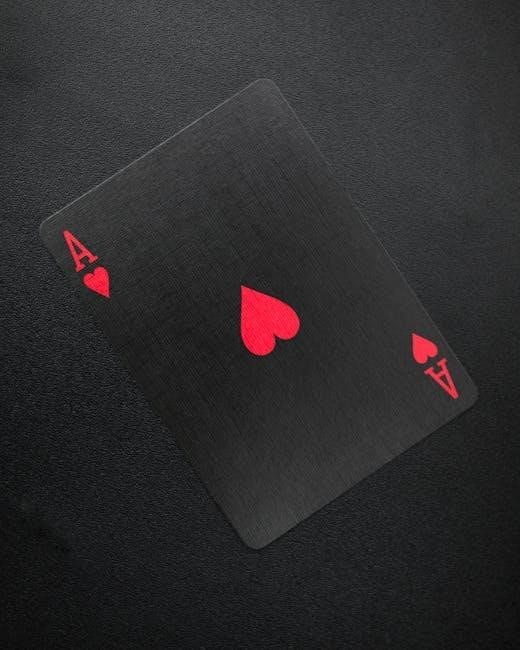Three Card Poker is a simple yet exciting game combining elements of poker and blackjack․ Its fast-paced nature and straightforward rules make it appealing to both newcomers and experienced players․ Discover how this popular casino game offers thrilling action and strategic depth in Three Card Poker, with this comprehensive guide to mastering its rules and strategies for success․
1․1 What is Three Card Poker?
Three Card Poker is a fast-paced casino game that blends elements of traditional poker with the simplicity of blackjack․ Played with a standard 52-card deck, it involves a player competing against the dealer, with the option to place bets on the strength of their hand; The game begins with an Ante bet, and players receive three cards․ The dealer also receives three cards, one face up and two face down․ Based on their hand strength, players can choose to fold or continue by placing a Play bet․ The game also offers optional side bets, like Pair Plus, which allows players to win based on the quality of their hand, regardless of the dealer’s hand․ Its simplicity and multiple betting options make Three Card Poker a favorite among both casual players and seasoned gamblers seeking excitement and strategic opportunities․
1․2 Brief History and Popularity
Three Card Poker was first introduced in the late 1990s by Derek Webb, a British casino owner and game inventor․ Designed to be fast-paced and easy to learn, the game quickly gained popularity in casinos worldwide․ Its simplicity and low house edge made it an attractive alternative to traditional poker games, which often require complex strategies․ The game’s popularity soared as it spread to land-based and online casinos, becoming a staple in many gaming venues․ Players appreciate its straightforward rules and the opportunity to win significant payouts through optional side bets like Pair Plus and Ante Bonuses․ Over the years, Three Card Poker has become a favorite among both casual players and experienced gamblers, cementing its place as one of the most enjoyable and accessible casino table games available today․

Basic Rules of Three Card Poker
Three Card Poker features straightforward gameplay with three-card hands dealt to both the player and the dealer․ The objective is to create the best possible hand, with clear rules guiding play․ This game combines luck and strategy, making it easy to learn while offering strategic depth for experienced players․ A comprehensive understanding of these rules is essential for mastering the game and maximizing your chances of success at the table․
2․1 How to Set Up the Game
Setting up Three Card Poker involves a standard 52-card deck and a table with designated betting areas․ The game is typically played with one deck, shuffled regularly to ensure fairness․ Each player and the dealer receive three cards, with the dealer’s cards dealt face down except for one face-up card․ The table includes areas for Ante, Pair Plus, and optional side bets․ Players place their initial bets before the cards are dealt, with the option to fold or continue after viewing their hand․ The dealer’s face-up card provides a strategic element, allowing players to make informed decisions․ Proper setup ensures smooth gameplay and adherence to the rules, making it essential for both new and experienced players to understand the initial arrangement of the game․
2․2 Objective of the Game
The primary objective of Three Card Poker is to create a stronger hand than the dealer or to have a hand that qualifies for a payout based on its ranking․ Players aim to make the best possible three-card hand from the cards they are dealt, using standard poker hand rankings․ The game offers two main betting options: the Ante bet, where the goal is to beat the dealer’s hand, and the Pair Plus bet, where the focus is on achieving a hand of at least a pair or higher․ By combining strategy and luck, players seek to maximize their chances of winning while enjoying the fast-paced action of the game․ Understanding the objective is crucial for making informed decisions during gameplay․
2․3 Basic Gameplay Rules

Three Card Poker begins with each player placing an Ante bet and/or a Pair Plus bet․ The dealer then deals three cards face-down to each player and themselves․ Players examine their cards and decide whether to fold, forfeiting their Ante bet, or to continue by placing a Play bet equal to the Ante bet․ The dealer reveals their hand and must have at least a Queen-high to qualify․ If the dealer’s hand doesn’t qualify, players receive a 1:1 payout on their Ante bet, and the Play bet is returned․ If the dealer qualifies, hands are compared, and players win if their hand is stronger․ Ties result in a push, returning the player’s bets․ The Pair Plus bet is independent and pays based on the player’s hand ranking, regardless of the dealer’s hand․ The game combines luck and strategy, offering an engaging experience for all players․
2․4 Ranking of Hands
In Three Card Poker, hands are ranked based on traditional poker rules, adapted for three-card dynamics․ The highest-ranking hand is a Straight Flush, followed by Three of a Kind, Straight, Flush, Pair, and High Card․ A Straight (e․g․, 3-4-5) ranks higher than a Flush, and a Flush beats a Straight in standard poker but not in Three Card Poker․ Pairs and High Cards are the most common hands․ Understanding these rankings is crucial for making informed decisions during gameplay․ Players should note that a Straight in Three Card Poker can consist of sequences like A-2-3 (called a “wheel”), which is the lowest-ranking Straight․ Additionally, the Ace can act as a high or low card in forming Straights․ Familiarizing yourself with these rankings will help you assess your hand strength accurately and improve your strategic choices at the table․
2․5 Betting Options and Payouts
In Three Card Poker, players typically have two primary betting options: the Ante and the Pair Plus․ Some games also offer a Progressive side bet․ The Ante bet is mandatory and is placed before the cards are dealt․ The Pair Plus bet is optional and wins if the player’s hand contains at least a pair․ Payouts vary depending on the hand ranking and the specific bet placed․ For example, a Straight Flush often pays 6:1 or higher, while a Pair may pay 1:1․ The Progressive bet can offer significant rewards, sometimes reaching into jackpots for top hands․ Understanding the payout structure is essential to maximizing your returns․ Always check the table’s payout chart, as ratios can vary between casinos and game variations․
2․6 Ante Bonus and Pair Plus Bonus
The Ante Bonus is a payout awarded to players for particularly strong hands, regardless of the dealer’s hand․ This bonus is typically paid on hands ranking as a Straight or higher․ For example, a Straight Flush might pay 5:1, while a Three of a Kind could pay 4:1․ These bonuses are paid in addition to the Ante bet payout if the player’s hand beats the dealer’s․ The Pair Plus Bonus is an optional side bet that rewards players for making a pair or better․ Payouts for this bet vary but often include 1:1 for a pair, 3:1 for Flushes, and higher for Strait Flushes․ Understanding these bonuses can enhance your strategy and maximize potential winnings in Three Card Poker․

Advanced Strategies for Three Card Poker
Mastering advanced strategies can elevate your game․ Learn optimal betting techniques, when to hold or fold, and how to manage your bankroll effectively․ These tips ensure smarter decisions and better outcomes․
3․1 When to Play the Ante Bet
Deciding when to play the Ante Bet is crucial in Three Card Poker․ Always consider your hand strength and the dealer’s upcard․ If you have a strong hand like a straight or higher, betting the Ante is advisable․ However, if your hand is weak, folding early can minimize losses․ A key strategy is to play hands that have a high chance of beating the dealer’s hand․ For example, if your hand ranks as a pair or better, it’s worth continuing․ Additionally, consider the Ante Bonus, which rewards strong hands regardless of the dealer’s outcome․ Balancing risk and potential rewards is essential․ By following these guidelines, you can make informed decisions and maximize your chances of winning while managing your bankroll effectively․
3․2 When to Fold: Key Decisions
Knowing when to fold is a critical aspect of Three Card Poker strategy․ If your hand is weak and has little chance of improving, folding early can help minimize losses․ Generally, you should fold if your hand ranks below a pair, as the odds of winning are low․ Additionally, consider the dealer’s upcard; if it’s a strong card (like a face card or Ace), folding may be the better option․ Avoid chasing marginal hands, as this can lead to unnecessary losses․ Folding also allows you to conserve your bankroll for more favorable opportunities․ By making disciplined fold decisions, you can reduce your overall risk and improve your long-term chances of success in the game․
3․3 Managing Your Bankroll
Managing your bankroll is essential for long-term success in Three Card Poker․ Set a budget and stick to it to avoid financial strain․ Determine your bet size based on your total bankroll, aiming to wager no more than 1-5% of it per hand․ This ensures you can weather losing streaks and maximize winning sessions․ Avoid chasing losses by increasing bets impulsively, as this can deplete your funds quickly․ Instead, set strict win and loss limits to maintain discipline․ Track your spending and adjust your strategy accordingly․ A well-managed bankroll allows you to enjoy the game responsibly while maintaining the potential for profitable play․ By prioritizing financial discipline, you can enhance your overall gaming experience and make informed decisions at the table․
3․4 Common Mistakes to Avoid
One of the most common mistakes in Three Card Poker is overestimating weak hands․ Players often hold onto hands like high card or low pairs, which rarely win․ Another error is chasing losses by increasing bets impulsively, leading to quicker bankroll depletion․ Many players also ignore the Ante Bonus, missing opportunities for additional payouts․ Overbetting relative to your bankroll is a costly mistake, as it can lead to financial strain․ Additionally, players sometimes fail to fold when they should, hoping to improve a poor hand․ Lastly, neglecting to follow basic strategy can significantly reduce your chances of winning․ Avoiding these mistakes requires discipline and a clear understanding of the game mechanics․ By being aware of these pitfalls, you can make smarter decisions and enhance your overall performance at the table․

Variations of Three Card Poker

Three Card Poker offers several variations to keep gameplay fresh and exciting, including Progressive, Prime, and Six Card Bonus options that add unique twists to the classic game․
4․1 Progressive Three Card Poker
Progressive Three Card Poker adds an thrilling twist to the classic game by introducing a jackpot component․ Players contribute to a progressive pool by placing a small side bet, creating a growing jackpot that can be won with specific hand rankings․ The game follows standard rules but includes an additional layer of excitement․ To qualify for the jackpot, players typically need a straight or better․ The progressive feature attracts those seeking higher rewards, though it comes with slightly lower odds․ This variation is perfect for players who enjoy the classic game but want the chance to win big․ The progressive jackpot adds an extra level of strategy and anticipation, making it a favorite among adventurous players․
4․2 Prime Three Card Poker
Prime Three Card Poker introduces a unique twist by incorporating a bonus bet based on the sum of the player’s and dealer’s hands․ If the combined total is a prime number, the player qualifies for a payout․ This variation adds an extra layer of strategy, as players must consider both their hand and the dealer’s potential cards․ The prime number bonus offers additional ways to win, with payouts varying based on the specific prime number achieved․ Players enjoy the excitement of this variation, as it blends traditional poker elements with a numerical twist․ The prime bonus creates more opportunities for smaller wins, making the game appealing to those who enjoy frequent payouts alongside the main game․ This variation is ideal for players seeking a fresh challenge with added winning possibilities․

4․3 Six Card Bonus Variation
The Six Card Bonus Variation in Three Card Poker adds an exciting twist by incorporating community cards into the gameplay․ In this version, players and the dealer each receive three cards, and three additional community cards are dealt face-up․ Players can use any combination of their three cards and the community cards to make their best five-card poker hand․ This variation introduces a new level of strategy, as players must consider both their own cards and the shared cards to form the highest possible hand․ The Six Card Bonus also offers a side bet that pays out based on the strength of the five-card hand, with payouts increasing for stronger hands like a straight, flush, full house, and royal flush․ This variation is popular among players who enjoy the challenge of combining strategy with a bit of luck to maximize their potential winnings․

Understanding the Three Card Poker PDF Guide
An essential read for both newcomers and seasoned players, the Three Card Poker PDF guide provides detailed rules, strategies, and tips․ This downloadable resource is perfect for offline study, offering a comprehensive overview of the game․ With clear explanations and examples, it helps players master the basics and advanced techniques․ The guide is also printable, making it easy to reference during practice or when refining your approach․ Whether you’re looking to improve your gameplay or simply understand the mechanics, the Three Card Poker PDF guide is an invaluable tool to enhance your skills and increase your chances of winning․
5․1 Why Use a PDF Guide?
A PDF guide is an excellent resource for learning Three Card Poker rules and strategies․ It provides a concise, well-organized format that allows players to access information quickly and easily․ PDF guides are portable and can be viewed on various devices, making them ideal for both online and offline learning․ They often include visual aids like charts and diagrams to help players understand hand rankings, betting options, and optimal plays․ Additionally, PDF guides are easily printable, enabling players to have a physical copy for reference during practice or study sessions․ This format is particularly beneficial for newcomers who want to grasp the fundamentals without the distractions of online content․ Overall, a PDF guide offers a comprehensive and accessible way to master Three Card Poker, ensuring players are well-prepared to succeed at the table․
5․2 Key Sections of a Three Card Poker PDF
A comprehensive Three Card Poker PDF typically includes several key sections designed to enhance understanding and improve gameplay․ The guide often starts with an overview of the game, covering its history and basic rules․ A detailed section on hand rankings is essential, explaining the hierarchy of hands from a straight flush to a high card․ Betting options and payout structures are also clearly outlined, helping players understand how to place bets effectively․ Strategies for both the Ante and Pair Plus bets are included, offering tips for optimal play․ Many PDF guides also feature sections on advanced tactics, such as when to fold or raise, and how to manage bankrolls․ Additionally, variations of the game and common mistakes to avoid are often highlighted․ These sections collectively provide a well-rounded resource for players of all skill levels․
5․3 Benefits of a Printable Guide
A printable Three Card Poker guide offers numerous benefits for players seeking to master the game․ Having a physical copy allows for easy reference during study or gameplay, eliminating the need for digital devices․ Players can highlight key strategies, annotate important rules, and keep the guide handy for quick reviews․ The portability of a printable guide makes it ideal for learning on the go or sharing with friends․ Additionally, a hard copy provides a distraction-free learning experience, helping players focus on improving their skills․ For visual learners, the ability to mark up the guide enhances retention of complex strategies․ Whether you’re a novice or an experienced player, a printable guide serves as a valuable tool for refining your approach to Three Card Poker and maximizing your chances of success at the table․

Additional Resources for Learning
Explore online tutorials, forums, and practice games to enhance your Three Card Poker skills․ These resources provide hands-on experience and expert tips, helping you refine your strategy and improve gameplay effectively․
6․1 Online Tutorials and Videos
Online tutorials and videos are excellent resources for mastering Three Card Poker․ Platforms like YouTube and casino websites offer step-by-step guides, gameplay demonstrations, and strategy breakdowns․ These videos cater to both beginners and experienced players, covering essential rules, hand rankings, and advanced tactics․ Many tutorials feature expert commentary, providing insights into optimal betting strategies and decision-making․ Additionally, some videos include interactive simulations, allowing viewers to practice in a virtual environment․ Watching these tutorials can help players understand the game’s nuances, such as when to fold or raise, and how to manage their bankroll effectively․ By leveraging these free and accessible resources, players can enhance their skills and confidence before playing in real-money games․ Online tutorials are a valuable tool for anyone looking to improve their Three Card Poker gameplay․
6․2 Forums and Communities
Forums and communities dedicated to Three Card Poker are invaluable for connecting with fellow players and experts․ Platforms like Reddit, specialized gambling forums, and casino communities offer a wealth of information and discussions․ Players can share strategies, ask questions, and learn from others’ experiences․ These communities often include seasoned players and professionals who provide insights into optimal play and common pitfalls․ Additionally, forums are great for staying updated on the latest trends, variations, and promotions related to Three Card Poker․ Engaging with these communities can help you refine your skills, gain confidence, and network with like-minded enthusiasts․ Whether you’re a novice or an experienced player, participating in forums adds a social and educational dimension to your learning journey․
6․3 Practice Games and Simulators

Practice games and simulators are essential tools for mastering Three Card Poker․ These platforms allow players to test strategies and gain hands-on experience without financial risk․ Many online casinos offer free demo versions of the game, enabling players to familiarize themselves with the rules and mechanics․ Simulators often include features like instant feedback on decisions and detailed statistics to track progress․ They are particularly useful for beginners to learn hand rankings and optimal betting strategies․ Additionally, practice games can help experienced players refine their tactics and explore new approaches in a risk-free environment․ By utilizing these resources, players can build confidence and improve their skills before transitioning to real-money games․ Practice games and simulators are indispensable for anyone aiming to enhance their Three Card Poker performance․
Three Card Poker is a simple, strategic game that combines luck and skill․ This guide has covered the essential rules, strategies, and tips to enhance your gameplay․ Start playing today and enjoy the excitement of Three Card Poker with confidence!
7․1 Summary of Three Card Poker Rules
In Three Card Poker, players compete against the dealer using three-card hands․ The game begins with an Ante bet, and each player receives three cards․ The dealer also gets three cards, one face up and two face down․ Players can choose to fold and lose their Ante bet or continue by placing a Play bet equal to the Ante․ The hands are then compared, and the highest-ranking poker hand wins․ Hand rankings follow traditional poker rules, with Straight Flush being the highest and High Card the lowest․ If the dealer’s hand is weaker than a straight or better, they don’t qualify, and players receive their Play bet back․ Payouts vary based on the strength of the hand and the betting options chosen․ Understanding these rules is essential for mastering the game and maximizing your chances of success․
7․2 Final Tips for Success
To excel at Three Card Poker, always remember to balance strategy with instincts․ Start by mastering the hand rankings and understanding when to hold or fold based on the dealer’s upcard․ Don’t chase losses—manage your bankroll wisely and set limits to ensure long-term enjoyment․ Avoid common mistakes like overestimating weak hands or underestimating the dealer’s potential․ Pay attention to the odds and probabilities, as they can significantly influence your decisions․ Practice with free online simulators to refine your skills before betting real money․ Stay calm, stay patient, and let the odds work in your favor․ By combining these tips with a solid understanding of the game, you’ll enhance your chances of success and enjoy a more rewarding experience at the table․ Happy gaming!



